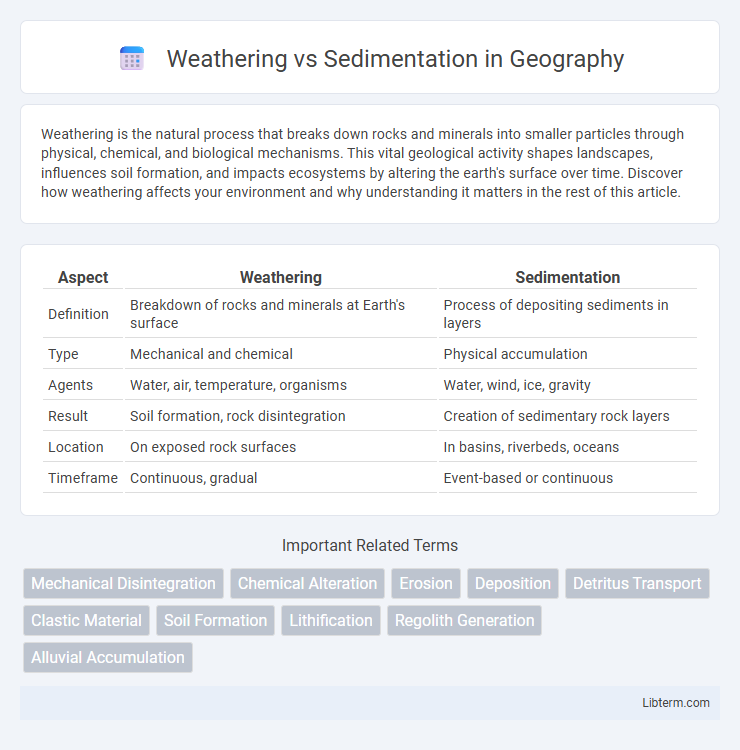Weathering is the natural process that breaks down rocks and minerals into smaller particles through physical, chemical, and biological mechanisms. This vital geological activity shapes landscapes, influences soil formation, and impacts ecosystems by altering the earth's surface over time. Discover how weathering affects your environment and why understanding it matters in the rest of this article.
Table of Comparison
| Aspect | Weathering | Sedimentation |
|---|---|---|
| Definition | Breakdown of rocks and minerals at Earth's surface | Process of depositing sediments in layers |
| Type | Mechanical and chemical | Physical accumulation |
| Agents | Water, air, temperature, organisms | Water, wind, ice, gravity |
| Result | Soil formation, rock disintegration | Creation of sedimentary rock layers |
| Location | On exposed rock surfaces | In basins, riverbeds, oceans |
| Timeframe | Continuous, gradual | Event-based or continuous |
Introduction to Weathering and Sedimentation
Weathering involves the physical and chemical breakdown of rocks into smaller particles, driven by natural forces such as temperature changes, water, and biological activity. Sedimentation is the process where these weathered particles are transported and deposited in new locations, often forming layers of sediment that contribute to soil and rock formation. Both weathering and sedimentation are essential geological processes that shape Earth's surface and influence soil fertility and landscape development.
Definition of Weathering
Weathering refers to the natural process of breaking down rocks, soils, and minerals through physical, chemical, or biological mechanisms, leading to their disintegration and alteration at or near the Earth's surface. It differs from sedimentation, which involves the accumulation and deposition of these weathered materials in new locations, forming sedimentary layers. Weathering plays a crucial role in landscape formation and soil development by transforming solid rock into smaller particles.
Definition of Sedimentation
Sedimentation is the geological process by which particles and sediments settle out of a fluid, typically water or air, and accumulate to form sediment layers. It plays a crucial role in the formation of sedimentary rocks and contributes to the stratification of the Earth's surface. Unlike weathering, which involves the breakdown of rocks, sedimentation focuses on the deposition and settling of material in new locations.
Types of Weathering
Physical weathering breaks down rocks through mechanical processes such as freezing and thawing, abrasion, and thermal expansion. Chemical weathering alters the mineral composition of rocks via reactions like oxidation, hydrolysis, and carbonation, leading to decomposition and soil formation. Biological weathering involves the actions of plants, animals, and microorganisms that produce acids or physically disrupt rock surfaces, accelerating both physical and chemical weathering processes.
Types of Sedimentation
Sedimentation involves the deposition of mineral and organic particles transported by wind, water, or ice, forming various types such as clastic, chemical, and organic sedimentation. Clastic sedimentation occurs through the accumulation of rock fragments and mineral grains, while chemical sedimentation results from precipitation of dissolved minerals like calcite and gypsum. Organic sedimentation forms from the accumulation of biological material, including plant debris and shell fragments, contributing to coal and limestone deposits.
Key Differences Between Weathering and Sedimentation
Weathering involves the breakdown of rocks and minerals into smaller particles through physical, chemical, or biological processes, while sedimentation refers to the deposition and accumulation of these particles in layers. Weathering occurs in situ at the site of rock exposure, whereas sedimentation takes place after material transport, usually in bodies of water like rivers, lakes, or oceans. The primary agents of weathering include temperature changes, water, and biological activity, whereas sedimentation is driven by gravity and fluid dynamics leading to sediment layer formation.
Processes Involved in Weathering
Weathering involves the physical breakdown and chemical alteration of rocks and minerals at or near the Earth's surface, driven by processes such as freeze-thaw cycles, oxidation, hydrolysis, and biological activity. Mechanical weathering fractures rocks into smaller particles without changing their composition, while chemical weathering transforms the mineral structure through reactions with water, oxygen, and acids. These weathering processes generate sedimentary particles that are subsequently transported and deposited during sedimentation, linking the two stages of the geological cycle.
Processes Involved in Sedimentation
Sedimentation involves processes such as erosion, transportation, deposition, and compaction of sediment particles. Sediments are carried by agents like water, wind, ice, and gravity before settling in layers in environments such as riverbeds, oceans, or deserts. Over time, these layers undergo lithification, transforming loose sediments into sedimentary rock.
Role in Earth’s Geological Cycle
Weathering breaks down rocks into smaller particles through physical, chemical, and biological processes, initiating the recycling of Earth's surface materials. Sedimentation involves the deposition and accumulation of these particles, forming sediment layers that eventually lithify into sedimentary rock. Together, weathering and sedimentation drive the geological cycle by continuously transforming and redistributing Earth's crustal materials.
Environmental and Human Impacts
Weathering breaks down rocks into smaller particles through physical, chemical, and biological processes, influencing soil formation and nutrient cycling critical for ecosystems. Sedimentation transports and deposits these weathered materials, shaping landforms and affecting water quality by trapping pollutants and altering aquatic habitats. Human activities such as deforestation and urbanization accelerate weathering and sedimentation rates, leading to increased soil erosion, habitat loss, and sediment pollution in rivers and coastal areas.
Weathering Infographic

 libterm.com
libterm.com